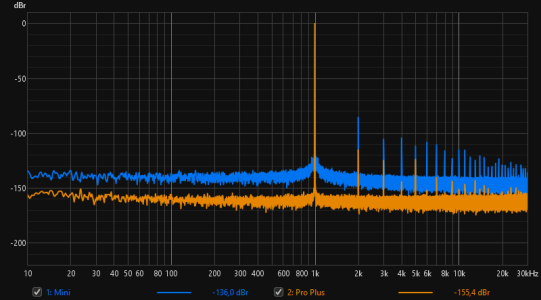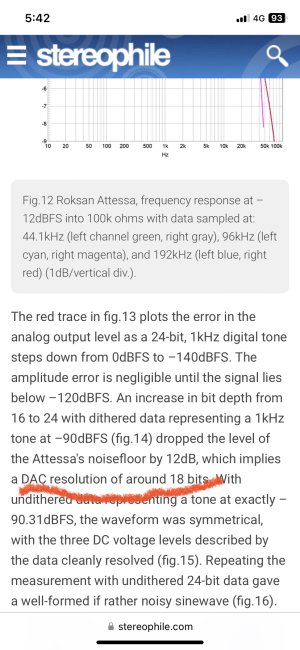At a moment I can tell that my sample unit has an increased space around the coax socket. And a glossy finish of the chassis.
Stay tuned
Part 0 - a test gear possibly involved
RME ADI-2 DAC FS, ESS edition
miniDSP Flex, RCA edition
E1DA Cosmos ADC, A grade
PicoScope 4444
Intona 7055-D isolator or ISOUSB211 based one - when needed
and some other less important stuff - powerbanks, Allo Nirvana SMPS, Icron Ranger 2201 USB extender, SPDIF Audio Switch by Beni, etc.
Part 1 - analog output - Pro vs Pro Plus combat
The fight begins. Both devices powered by Xiaomi battery packs, both use the strongest 2 Vrms outputs.
Pro's FW is 4.8.523533.
For the Pro Plus is was 4.8.521533 initially, and later 4.8.523842 with a fix for the reported bug.
Edit: 4.8.524946 has been released to fix locked 16 bit depth output for ADC.
Round 1 - power consumption
The Pro Plus is more power hungry. It needs almost 2.6 W (0.5 A / 5.1 V) when idle with a wired network. It rises to above 4.5 W (0.9 A / 5.1 V) when sine 1 kHz at 96 kHz is played. On the other hand the Pro needs 1.3 W (0.25 A / 5.1 V) and almost 1.7 W (0.32 A / 5.1 V) respectively.
Round 2 - output signal voltage
The Pro Plus real output voltage level is 1.973 Vrms for both channels, for sine 1 kHz at 96 kHz. For the Pro it's slightly unbalanced 2.012 for the left channel and 2.006 for the right channel. Values measured with a multimeter.
Round 3 - REW measurements
My Pro unit measures slightly better on its left channel while for the Pro Plus it's the right one, so better channels are compared unless stated otherwise.
All the measured values are presented as Pro vs Pro Plus.
Sine 1k 48 kHz:

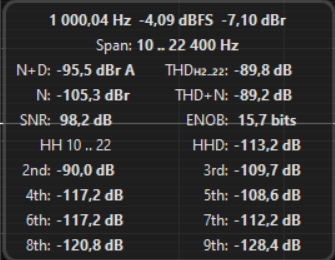
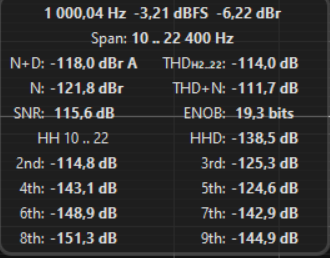
Significant 22.5 dB difference in SINAD.
SMPTE 48 kHz:
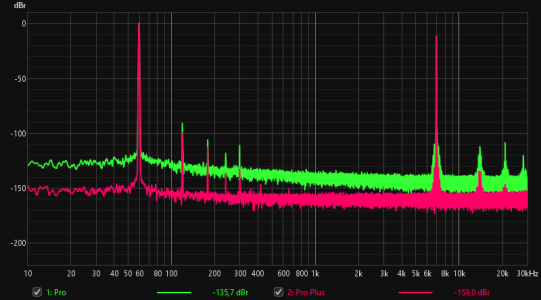
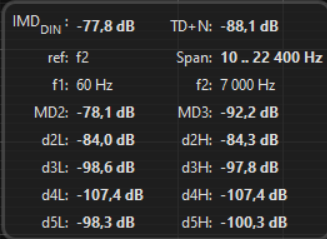
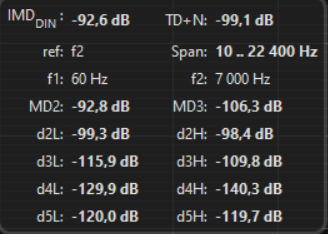
Clear advantage of the Pro Plus but low freq harmonics higher than expected.
CCIF 48 kHz:

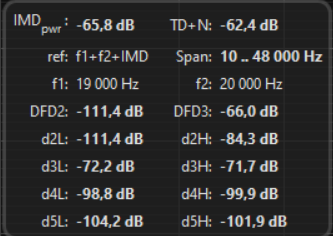
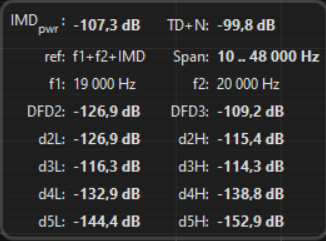
Another test for intermodulation distortions, this time with a wider bandwidth included in the calculations. Looks like Pro's Achilles heel, it's performance is horrible here. Pro Plus can shine.
Multitone 48 kHz:
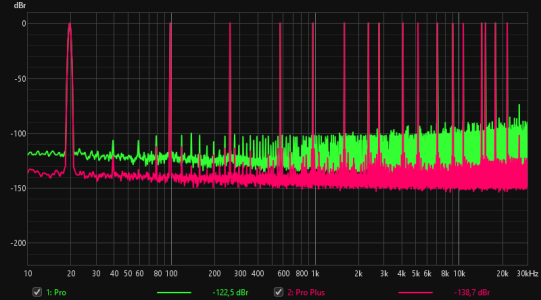
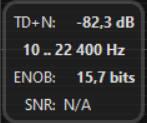
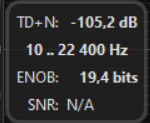
The test which focuses more on the real life performance. IMD tests issues mentioned before are clearly visible.
DAC filters:
The Pro seems to use a kind of fast linear phase filter with the response as below:
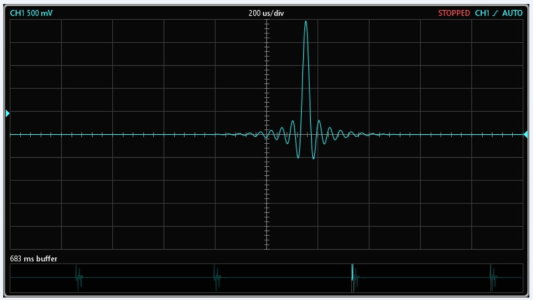
The Pro Plus uses rather a fast minimum phase filter:
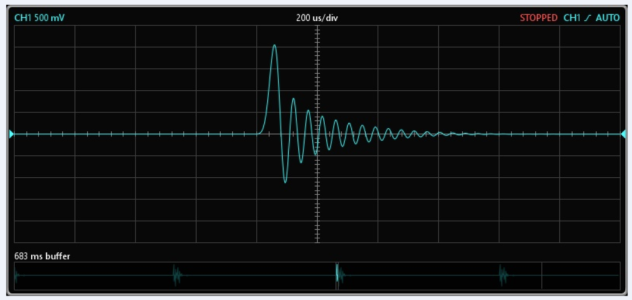
Attenuation of the Pro Plus filter is much more effective (48 kHz):
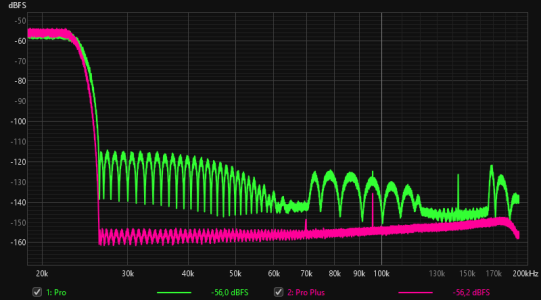
Internal headroom management:
A test to see how the unit can handle intersample peaks. Lets imagine we have a test signal with sample peaks at the max allowed 0 dBFS level, but these samples are not sine wave peaks. On the picture below we can see possible clipping areas if the device cannot provide a sufficient amount of headroom to handle it.
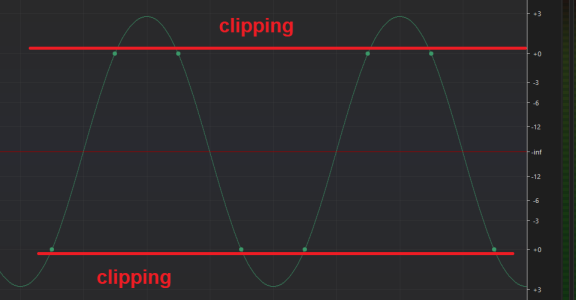
To test it I've prepared 4 test signals with sample peak levels from 0 dBFS to -5 dBFS, and intersample peaks from +3.02 dBFS to -1.98 dBFS.
The Pro results:
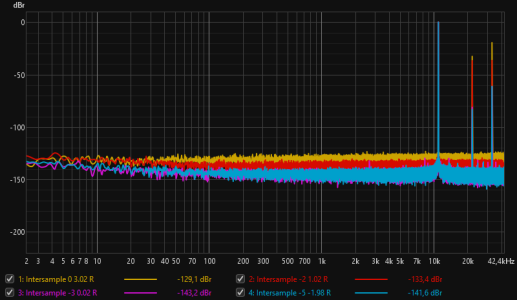
1 and 2 are clipping, 3 and 4 remain the same. Looks like there is no internal headroom or it's just minimal.
The Pro Plus results:
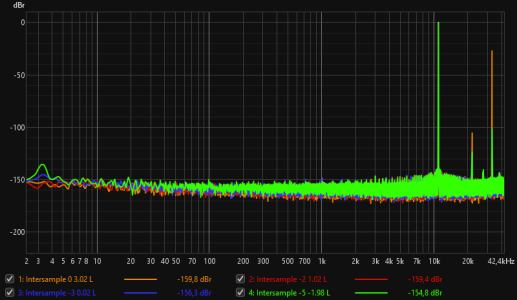
Only 1 is clipping. The headroom wasn't big enough to handle +3.02 dBFS peaks, but it's above 1 dB.
Edit:
One more test added for intersample +2.02 dBFS peak:
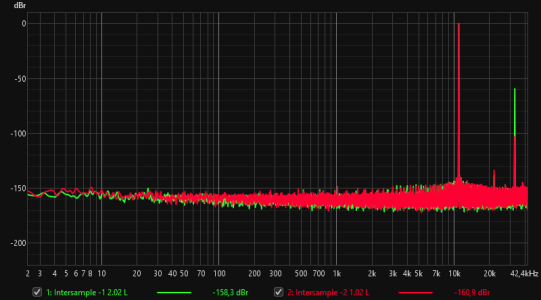
It clips for such level, so the headroom is somewhere in the range 1-2 dB.
Dynamic Range:
It's calculated using a sine 1 kHz signal at -60 dBFS level.

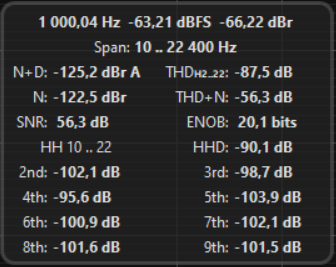
Pro: 44.1 + 60 = 104.1 dB
Pro Plus: 56.3 + 60 = 116.3 dB
Being idle / playing silence:
The noise level when device is doing nothing or when it plays a silence stream - all the samples are zeroed. Also the cases where the PSU used usually impacts measurement plots, especially when the device is idle.
For the Pro idle and silence look different:
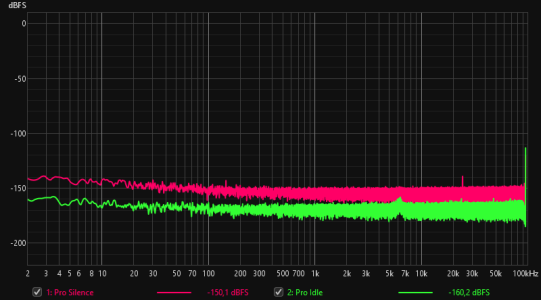
No idle mode artifacts coming from the PSU, but it's a battery pack used here.
There is no such noise level difference for the Pro Plus, although an alone component appears:
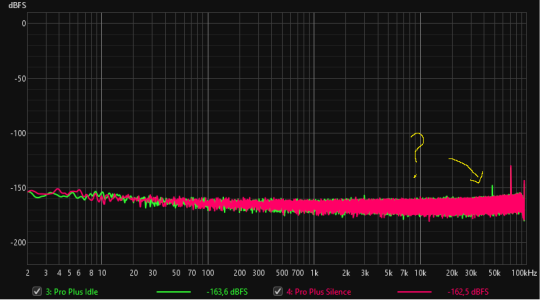
The Pro Plus seems to be perfectly muted when playing a silence.
THD vs frequency, sweep -3 dBFS:
A sweep signal can deliver some information regarding the relation between harmonic distortions level and a frequency of the fundamental.
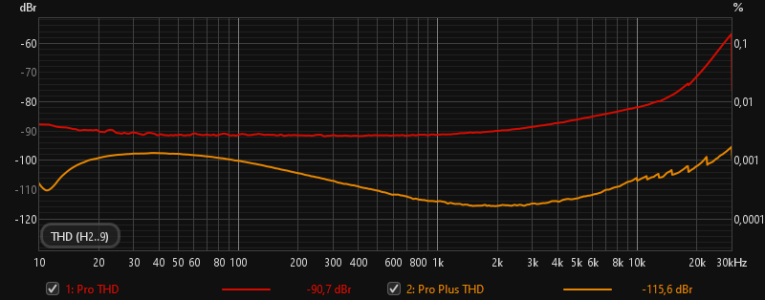
A kind of trouble with low frequency distortions is visible here for the Pro Plus. Bad Pro's performance with high frequencies also shown.
Part 2 - a closer look onto Pro Plus analog output
Output voltage levels:
There are 4 output voltage levels available, 2 Vrms, 1 Vrms, 0.8 Vrms and 0.5 Vrms. How does it affect the performance?

While the voltage level decreases a SINAD decreases as well (sine 1k 48 kHz).
2 Vrms - SINAD 111.7
1 Vrms - SINAD 109.4
0.8 Vrms - SINAD 107.6
0.5 Vrms - SINAD 103.8
Voltage levels measured by PicoScope using sine 1k 48kHz signal:
1.977
0.990
0.784
0.495
There is a lot of headroom on 1 Vrms output. No clipping at all for intersample peak tests regardless of the signal level:

What if I change the power source?
An ordinary Huawei phone charger is the first candidate. Labeled as 2A maximum, is strong enough to power the Pro Plus.
Did I notice performance decrease in my 38 synthetic tests? Not at all.
The Allo Nirvana ultra low noise SMPS is next. No serious improvement again, but at least I've caught a difference:
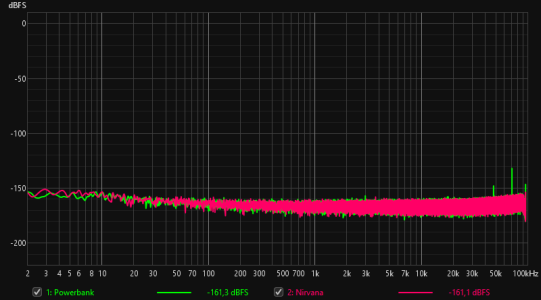
It's a removal of insignificant ultrasonic components in the idle test which is the most sensitive for any PSU changes. That's all.
I can guess that the Pro Plus PSR ratio is high enough to make it quite immune to common SMPS ripples and noise.
I will give the Nirvana SMPS a second chance during listening tests.
Low frequency THD:
A closer look reveals a behavior similar to the infamous ESS hump, more common for implementations of ESS chipsets, where distortions level rises in a specific way:
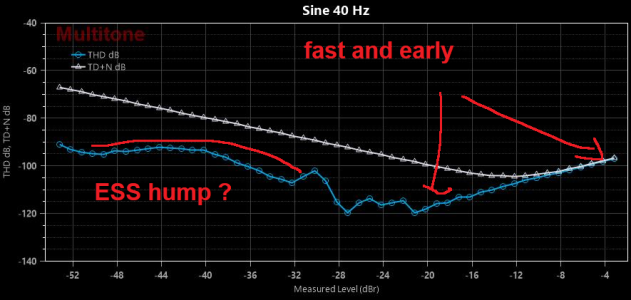
"Better optimized" 1k signal doesn't grow so rapidly:
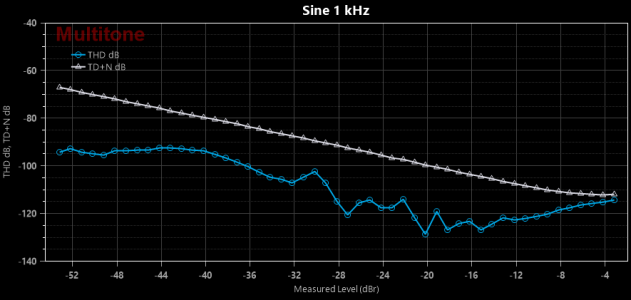
Unexpected behavior of low frequency distortions is also visible on IMD graph below, which uses SMPTE test signal:

It should be noticed that although these higher than expected harmonic distortions levels are significant in terms of measurements, their audibility is rather questionable and probably should not bother.
Part 3 - the digital domain
Streaming to digital outputs with bit-perfect capable interface:
The Pro Plus has been connected to RME ADI-2 DAC FS, which will act as the spdif-usb interface to let me analyze the Pro Plus output. All the DSP features of the Pro Plus are disabled.
Nothing unusual here, the Pro Plus is fully digital transparent on both coax and toslink outputs, just like any other WiiM. It also passes all RME bit-perfect tests up to 24 bit depth.
Toslink input to digital outputs with RME ADI-2 DAC FS:
The Pro Plus still connected to RME ADI-2 DAC FS, but an additional device appears here - SMSL PO100 Pro, which acts as the usb-spdif interface to let me feed the Pro Plus.
The Pro Plus is again fully digital transparent on both coax and toslink outputs.
There is also a surprise here. The Pro was suspected to perform a signal reclocking of the input stream to its internal clock, which could result in some unwanted behaviors like clicks and pops. But what do I see in REW when using its generator:
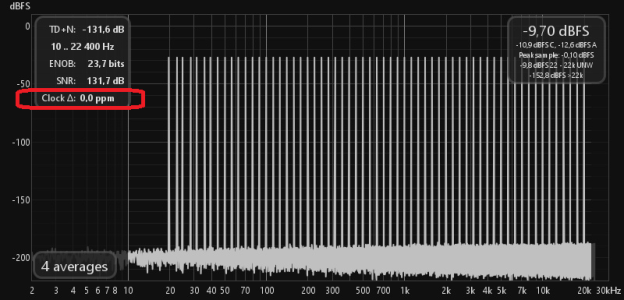
An audio chain is:
PC (REW generator) -> usb-spdif -> Pro Plus input -> Pro Plus output -> spdif-usb -> PC (REW capture)
For such scenario the source signal is clocked by usb-spdif interface (PO100 and XMOS clock). There is no discrepancy with the clock captured on the PC, I believe it can be a sign that the reclocking on the Pro Plus wasn't made. The same behavior can be seen with both toslink and coax outputs.
Another possible argument for this assumption is a drift calculation between the input and the output in Multitone Analyzer:
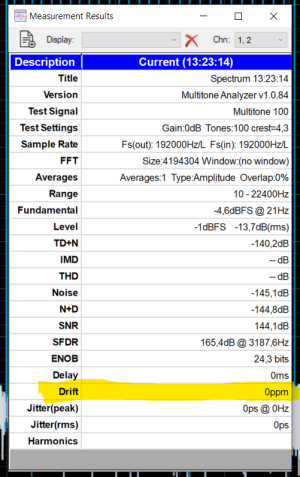
I will evaluate this theory later with a different capture interface.
What about the latency between digital input and output?
For 192 kHz signal, the latency measured in Audacity, toslink in -> toslink out, is 44 ms.
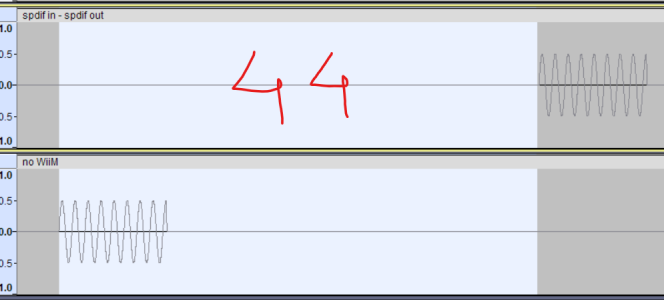
For toslink in -> coax out, it is 49 ms.
Toslink input to toslink output with miniDSP Flex:
Time to investigate further a possible reclocking behavior on the digital input of the Pro Plus. The Mini will feed the input this time and the Pro Plus is connected to miniDSP Flex via toslink. As the Flex uses ASRC to reclock any input to its own internal clock, it will let me see when the incoming clock varies. So 3 cases to be analyzed:
- Mini connected directly to the Flex
- Mini connected to the Pro Plus which is connected to the Flex
- Pro Plus connected alone to the Flex
I've captured 24 sec audio content, it has been sample aligned at the beginning in Audacity. Results:

Mini connected to the Pro Plus behaves like the Pro Plus here. Its spdif stream is reclocked by the Pro Plus and later sent with the clock of Pro Plus. The reclocking can happen on the Pro Plus similar way it's possible on the Pro.
Streaming to digital outputs with ASRC interface:
I haven't observed any significant differences between the Pro and the Pro Plus when connected to miniDSP Flex. For example j-test plot quality looks very similar for both devices, REW:

Or in Multitone Analyzer:
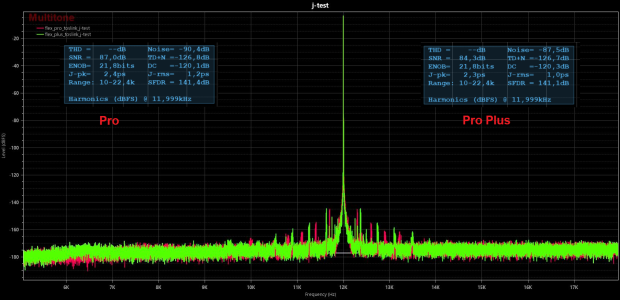
Probably the digital section of the Pro Plus remains the same, or very similar, to the one of the Pro.
Part 4 - time for a short, analog break, although served in the digital form:
Three devices, two WiiMs, 1 DAC. One of them is the Pro Plus. The analog output was used every time. No mapping to the names included. Have fun
Audio test sound source provided by: (C) Maestro Tacky (https://globalaudio.info/page-2358/)
オーディオテスト音源提供:(C)マエストロTacky(https://globalaudio.info/page-2358/)
 drive.google.com
drive.google.com
Edit: a new link to the same content but recorded with slightly different, more polished (because I'm Polish ) procedure. Difference between samples from this pack and the previous one should be inaudible.
) procedure. Difference between samples from this pack and the previous one should be inaudible.
 drive.google.com
drive.google.com
Part 5 - WiiM Pro Plus vs RME ADI-2 DAC FS - analog output performance:
Both devices with left channel, measured again using E1DA Cosmos ADC. ADI-2 unbalanced output level calibrated at 1.977 Vrms to be equal with the Pro Plus level. The Pro Plus presented first with measurements results.
Sine 1k 48 kHz:
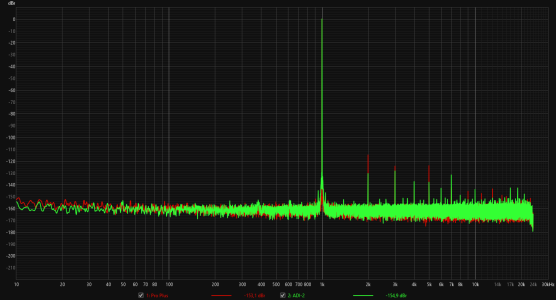


Sine 12k 48 kHz:
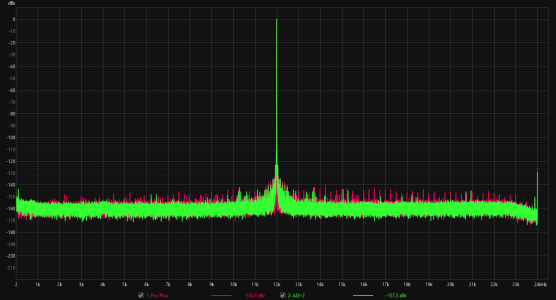
IMD SMPTE 48 kHz:
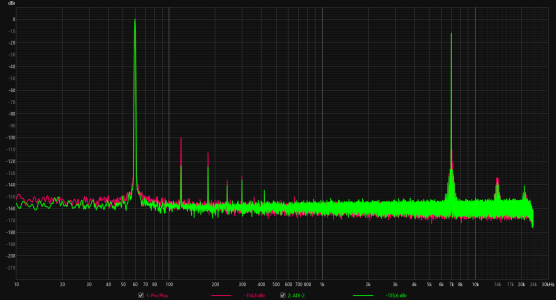
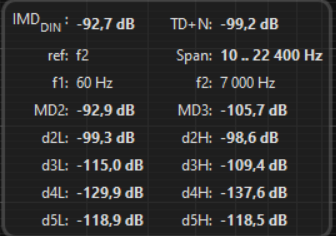
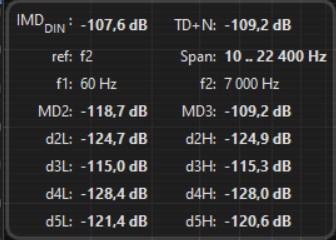
Multitone 48 kHz:
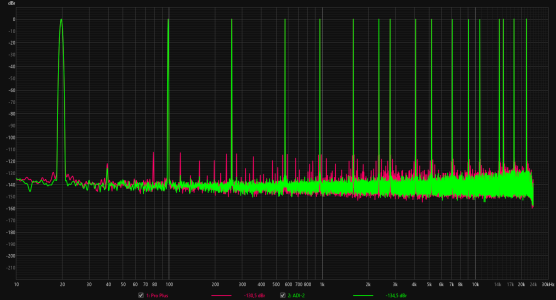
THD vs signal level for sine 1k, 48 kHz:

THD vs signal level for sine 40 Hz, 48 kHz:
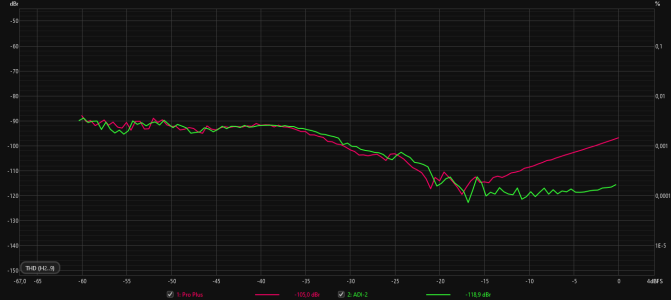
THD vs frequency for sine, 192 kHz:
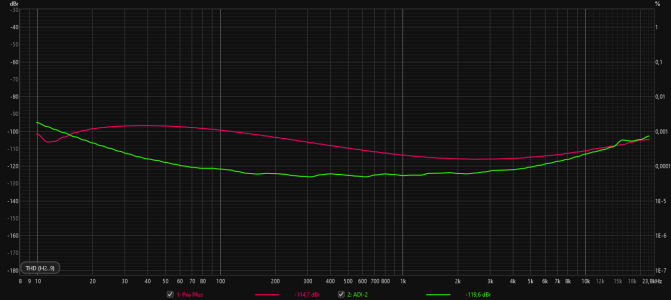
DAC filters:
"SD Sharp" selected on ADI-2 to match the filter on the Pro Plus.

Part 6 - ADC performance:
In one of my comments below:
 forum.wiimhome.com
forum.wiimhome.com
Epilogue
The main part ends here alhough some supplements may come later. I consider the Pro Plus to be a significant improvement over the Pro for the analog section, despite some downsides related to low frequencies performance or a weaker ADC. If you need a modern device which promises a solid analog performance without a need to use an external DAC, the Pro Plus might be for you. If you don't care about the onboard DAC or ADC, the new model has nothing to offer compared to the Pro. And yes, being comparable even to 500 usd DACs is a bold statement, too bold I would say.
If you think this is a criticism mainly above, not at all. The Pro Plus is an extremely competitive product with great customer value, that's my honest opinion. Period.
Thanks to the Linkplay team for giving me an opportunity to test the device before its release.
Stay tuned
Part 0 - a test gear possibly involved
RME ADI-2 DAC FS, ESS edition
miniDSP Flex, RCA edition
E1DA Cosmos ADC, A grade
PicoScope 4444
Intona 7055-D isolator or ISOUSB211 based one - when needed
and some other less important stuff - powerbanks, Allo Nirvana SMPS, Icron Ranger 2201 USB extender, SPDIF Audio Switch by Beni, etc.
Part 1 - analog output - Pro vs Pro Plus combat
The fight begins. Both devices powered by Xiaomi battery packs, both use the strongest 2 Vrms outputs.
Pro's FW is 4.8.523533.
For the Pro Plus is was 4.8.521533 initially, and later 4.8.523842 with a fix for the reported bug.
Edit: 4.8.524946 has been released to fix locked 16 bit depth output for ADC.
Round 1 - power consumption
The Pro Plus is more power hungry. It needs almost 2.6 W (0.5 A / 5.1 V) when idle with a wired network. It rises to above 4.5 W (0.9 A / 5.1 V) when sine 1 kHz at 96 kHz is played. On the other hand the Pro needs 1.3 W (0.25 A / 5.1 V) and almost 1.7 W (0.32 A / 5.1 V) respectively.
Round 2 - output signal voltage
The Pro Plus real output voltage level is 1.973 Vrms for both channels, for sine 1 kHz at 96 kHz. For the Pro it's slightly unbalanced 2.012 for the left channel and 2.006 for the right channel. Values measured with a multimeter.
Round 3 - REW measurements
My Pro unit measures slightly better on its left channel while for the Pro Plus it's the right one, so better channels are compared unless stated otherwise.
All the measured values are presented as Pro vs Pro Plus.
Sine 1k 48 kHz:



Significant 22.5 dB difference in SINAD.
SMPTE 48 kHz:



Clear advantage of the Pro Plus but low freq harmonics higher than expected.
CCIF 48 kHz:



Another test for intermodulation distortions, this time with a wider bandwidth included in the calculations. Looks like Pro's Achilles heel, it's performance is horrible here. Pro Plus can shine.
Multitone 48 kHz:



The test which focuses more on the real life performance. IMD tests issues mentioned before are clearly visible.
DAC filters:
The Pro seems to use a kind of fast linear phase filter with the response as below:

The Pro Plus uses rather a fast minimum phase filter:

Attenuation of the Pro Plus filter is much more effective (48 kHz):

Internal headroom management:
A test to see how the unit can handle intersample peaks. Lets imagine we have a test signal with sample peaks at the max allowed 0 dBFS level, but these samples are not sine wave peaks. On the picture below we can see possible clipping areas if the device cannot provide a sufficient amount of headroom to handle it.

To test it I've prepared 4 test signals with sample peak levels from 0 dBFS to -5 dBFS, and intersample peaks from +3.02 dBFS to -1.98 dBFS.
The Pro results:

1 and 2 are clipping, 3 and 4 remain the same. Looks like there is no internal headroom or it's just minimal.
The Pro Plus results:

Only 1 is clipping. The headroom wasn't big enough to handle +3.02 dBFS peaks, but it's above 1 dB.
Edit:
One more test added for intersample +2.02 dBFS peak:

It clips for such level, so the headroom is somewhere in the range 1-2 dB.
Dynamic Range:
It's calculated using a sine 1 kHz signal at -60 dBFS level.


Pro: 44.1 + 60 = 104.1 dB
Pro Plus: 56.3 + 60 = 116.3 dB
Being idle / playing silence:
The noise level when device is doing nothing or when it plays a silence stream - all the samples are zeroed. Also the cases where the PSU used usually impacts measurement plots, especially when the device is idle.
For the Pro idle and silence look different:

No idle mode artifacts coming from the PSU, but it's a battery pack used here.
There is no such noise level difference for the Pro Plus, although an alone component appears:

The Pro Plus seems to be perfectly muted when playing a silence.
THD vs frequency, sweep -3 dBFS:
A sweep signal can deliver some information regarding the relation between harmonic distortions level and a frequency of the fundamental.

A kind of trouble with low frequency distortions is visible here for the Pro Plus. Bad Pro's performance with high frequencies also shown.
Part 2 - a closer look onto Pro Plus analog output
Output voltage levels:
There are 4 output voltage levels available, 2 Vrms, 1 Vrms, 0.8 Vrms and 0.5 Vrms. How does it affect the performance?

While the voltage level decreases a SINAD decreases as well (sine 1k 48 kHz).
2 Vrms - SINAD 111.7
1 Vrms - SINAD 109.4
0.8 Vrms - SINAD 107.6
0.5 Vrms - SINAD 103.8
Voltage levels measured by PicoScope using sine 1k 48kHz signal:
1.977
0.990
0.784
0.495
There is a lot of headroom on 1 Vrms output. No clipping at all for intersample peak tests regardless of the signal level:

What if I change the power source?
An ordinary Huawei phone charger is the first candidate. Labeled as 2A maximum, is strong enough to power the Pro Plus.
Did I notice performance decrease in my 38 synthetic tests? Not at all.
The Allo Nirvana ultra low noise SMPS is next. No serious improvement again, but at least I've caught a difference:

It's a removal of insignificant ultrasonic components in the idle test which is the most sensitive for any PSU changes. That's all.
I can guess that the Pro Plus PSR ratio is high enough to make it quite immune to common SMPS ripples and noise.
I will give the Nirvana SMPS a second chance during listening tests.
Low frequency THD:
A closer look reveals a behavior similar to the infamous ESS hump, more common for implementations of ESS chipsets, where distortions level rises in a specific way:

"Better optimized" 1k signal doesn't grow so rapidly:

Unexpected behavior of low frequency distortions is also visible on IMD graph below, which uses SMPTE test signal:

It should be noticed that although these higher than expected harmonic distortions levels are significant in terms of measurements, their audibility is rather questionable and probably should not bother.
Part 3 - the digital domain
Streaming to digital outputs with bit-perfect capable interface:
The Pro Plus has been connected to RME ADI-2 DAC FS, which will act as the spdif-usb interface to let me analyze the Pro Plus output. All the DSP features of the Pro Plus are disabled.
Nothing unusual here, the Pro Plus is fully digital transparent on both coax and toslink outputs, just like any other WiiM. It also passes all RME bit-perfect tests up to 24 bit depth.
Toslink input to digital outputs with RME ADI-2 DAC FS:
The Pro Plus still connected to RME ADI-2 DAC FS, but an additional device appears here - SMSL PO100 Pro, which acts as the usb-spdif interface to let me feed the Pro Plus.
The Pro Plus is again fully digital transparent on both coax and toslink outputs.
There is also a surprise here. The Pro was suspected to perform a signal reclocking of the input stream to its internal clock, which could result in some unwanted behaviors like clicks and pops. But what do I see in REW when using its generator:

An audio chain is:
PC (REW generator) -> usb-spdif -> Pro Plus input -> Pro Plus output -> spdif-usb -> PC (REW capture)
For such scenario the source signal is clocked by usb-spdif interface (PO100 and XMOS clock). There is no discrepancy with the clock captured on the PC, I believe it can be a sign that the reclocking on the Pro Plus wasn't made. The same behavior can be seen with both toslink and coax outputs.
Another possible argument for this assumption is a drift calculation between the input and the output in Multitone Analyzer:

I will evaluate this theory later with a different capture interface.
What about the latency between digital input and output?
For 192 kHz signal, the latency measured in Audacity, toslink in -> toslink out, is 44 ms.

For toslink in -> coax out, it is 49 ms.
Toslink input to toslink output with miniDSP Flex:
Time to investigate further a possible reclocking behavior on the digital input of the Pro Plus. The Mini will feed the input this time and the Pro Plus is connected to miniDSP Flex via toslink. As the Flex uses ASRC to reclock any input to its own internal clock, it will let me see when the incoming clock varies. So 3 cases to be analyzed:
- Mini connected directly to the Flex
- Mini connected to the Pro Plus which is connected to the Flex
- Pro Plus connected alone to the Flex
I've captured 24 sec audio content, it has been sample aligned at the beginning in Audacity. Results:

Mini connected to the Pro Plus behaves like the Pro Plus here. Its spdif stream is reclocked by the Pro Plus and later sent with the clock of Pro Plus. The reclocking can happen on the Pro Plus similar way it's possible on the Pro.
Streaming to digital outputs with ASRC interface:
I haven't observed any significant differences between the Pro and the Pro Plus when connected to miniDSP Flex. For example j-test plot quality looks very similar for both devices, REW:

Or in Multitone Analyzer:

Probably the digital section of the Pro Plus remains the same, or very similar, to the one of the Pro.
Part 4 - time for a short, analog break, although served in the digital form:
Three devices, two WiiMs, 1 DAC. One of them is the Pro Plus. The analog output was used every time. No mapping to the names included. Have fun
Audio test sound source provided by: (C) Maestro Tacky (https://globalaudio.info/page-2358/)
オーディオテスト音源提供:(C)マエストロTacky(https://globalaudio.info/page-2358/)
Pack 1 – Google Drive
 drive.google.com
drive.google.com
Edit: a new link to the same content but recorded with slightly different, more polished (because I'm Polish
Pack 1a – Google Drive
 drive.google.com
drive.google.com
Part 5 - WiiM Pro Plus vs RME ADI-2 DAC FS - analog output performance:
Both devices with left channel, measured again using E1DA Cosmos ADC. ADI-2 unbalanced output level calibrated at 1.977 Vrms to be equal with the Pro Plus level. The Pro Plus presented first with measurements results.
Sine 1k 48 kHz:



Sine 12k 48 kHz:

IMD SMPTE 48 kHz:



Multitone 48 kHz:

THD vs signal level for sine 1k, 48 kHz:

THD vs signal level for sine 40 Hz, 48 kHz:

THD vs frequency for sine, 192 kHz:

DAC filters:
"SD Sharp" selected on ADI-2 to match the filter on the Pro Plus.

Part 6 - ADC performance:
In one of my comments below:
My WiiM Pro Plus (+) tests
Are the dimensions of the Plus and Plus Pro cases the same?
Epilogue
The main part ends here alhough some supplements may come later. I consider the Pro Plus to be a significant improvement over the Pro for the analog section, despite some downsides related to low frequencies performance or a weaker ADC. If you need a modern device which promises a solid analog performance without a need to use an external DAC, the Pro Plus might be for you. If you don't care about the onboard DAC or ADC, the new model has nothing to offer compared to the Pro. And yes, being comparable even to 500 usd DACs is a bold statement, too bold I would say.
If you think this is a criticism mainly above, not at all. The Pro Plus is an extremely competitive product with great customer value, that's my honest opinion. Period.
Thanks to the Linkplay team for giving me an opportunity to test the device before its release.
Last edited:


